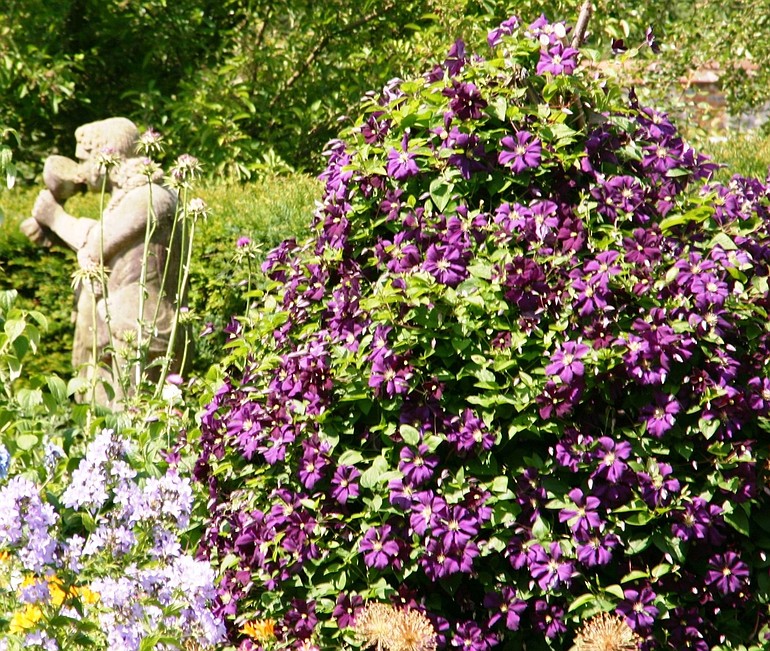Although we got off to a late start, it has been a fabulous year for a variety of vines in the Northwest garden.
Beginning the garden season with the evergreen climber, Clematis armandii “Snowdrift,” one can add a rambling rose, climbing clematis or trailing honeysuckle to highlight the garden through fall and even into early winter. Climbing plants add a vertical element to the garden, drawing the eye up from the level of perennials and shrubbery, into the realm of trees and sky.
The family of vines displays a wide variety of distinct personalities, from large, rampant climbing roses to tiny-flowered, shrub-clinging clematis. Because of their ability to rise above other flowering plants in beds and borders, most stand out like prima donnas, flaunting their attributes for all to see. When vines finally reach the peak of their individual forms, they really do deserve the ogling admiration they so often attract.
The Chinese wisteria is strong, rangy and beautiful in a handsome, powerful way. Clematis are elegant and floriferous. The Parthenocissus family, which includes Boston ivy and Virginia creeper, is as varied as the world of monkeys, clambering up the walls of houses and barns. Roses, while not really vines, can be trained in wide, upright arches to boost flower production and show their blossoms to perfection. Golden hops will lead the eye up a post to a birdhouse.
A clematis vine, planted in a tree, will wend its way through the branches and peek its own flowers out into the sunlight, adding an additional season of bloom.
One of my personal favorites is the tongue twisting Ampelopsis brevipedunculata “Elegans.” Better known as the porcelain-berry vine, this is a must-have plant if your garden has the conditions to grow it well. This rampant woody vine climbs by stem tendrils. Its deeply cut leaves are mottled dark green, light green and cream with subtle hints of pink in spring and fall. On top of that, in late summer an explosion of petite flowers will mature into shiny, enameled berries of deep purple, blue and turquoise.
Vines’ varied needs
Although we think of vines as similar to each other, they are as varied as any other group of plants. Individual vines will demand specific growing conditions, so make it a point to read the label or ask your nursery for exact planting instructions on the vine you are interested in planting. The plant tags that come with vines will give you water and light requirements as well as the plant’s ultimate size. Just one more reason to save those plant tags.
All vines like well-drained soil, a well-composted foothold for their roots and substantial water through their flowering season. Add generous amounts of compost or any organic planting mix to the planting hole. For ultimate flowering and best leaf production, a vine needs to be spread out over a large surface with the maximum amount of flowering wood exposed to air and sunlight. This makes them perfect as an espalier on a wall.
For many, the idea of pruning a vine is intimidating. Try it; it’s easier than you think and worth the effort. Vines are forgiving and will quickly repair any pruning mistakes.
Keep in mind that most vines in our climate are deciduous, although some will hold onto leaves in a mild winter. Know what you are cutting before you prune. The dormant winter wood on vines looks dead. If you do cut it off, you may be removing the buds of next year’s flowers.
If you are looking for a vine with year-round presence, I will refer you back to the evergreen clematis (Clematis armandii).
Masses of scented white blossoms in spring and the languishing drape of the long, leathery, dark green leaves in summer give this vine a unique interest. End the flowering vine season with Sweet Autumn clematis (C. paniculata, also known as C. terniflora) or with the fluffy seed heads of the golden Clematis tangutica.
My favorite vine is commonly called Silvervein Creeper. The Latin name is Parthenocissus henryana. This is a sweet vine, not overly rampant and not too large, that can be trained to grow on a wooden or chain link fence or up the side of a building. The leaves open purple, turning a dark bronzy green with pronounced silver veining. The foliage is delicately detailed yet quite dramatic. Take my advice and try this one. You can thank me in October when the blazing red leaf color steals the garden show.
Robb Rosser is a WSU-certified Master Gardener. Reach him at Write2Robb@aol.com.



